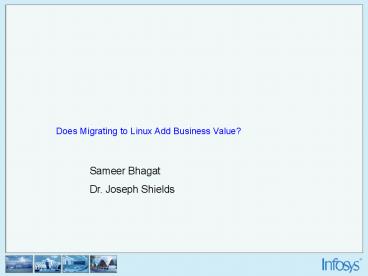A1256655815lFPyp - PowerPoint PPT Presentation
1 / 18
Title:
A1256655815lFPyp
Description:
Is Linux really cheaper to established OSes such as Windows and ... Erasing and shifting sensitive data. Disposal of the equipment. Hardware : Hardware Purchase ... – PowerPoint PPT presentation
Number of Views:47
Avg rating:3.0/5.0
Title: A1256655815lFPyp
1
Does Migrating to Linux Add Business Value?
Sameer Bhagat Dr. Joseph Shields
2
Why do firms look at migrating to alternative OS
platforms?
Higher Productivity
Improved Governance
Meeting Customer Demands
Lower security risk
Capital and Asset Utilization
Pricing Pressures
Better software quality
Increased Computational Power
3
Questions to ask while evaluating benefits of
migration to Linux
Is Linux really cheaper to established OSes such
as Windows and proprietary Unix? To answer this
questions and justify the investment, two types
of financial metrics are commonly used Total
Cost of Ownership (TCO) Return on Investment
(ROI)
While TCO measures both direct and indirect costs
of alternative implementations, it makes no
measure of the benefits gained from that
implementation. Return on Investment, in
comparison, includes cost factors but also
includes the value of the resulting benefits to
the enterprise attributable to the investment.
It projects the value of the product, not simply
the cost.
4
Getting a good view of ROI
Building blocks of ROI Estimation
View of Benefits
5
Suggested approach for cost benefit analysis
- Multiple stakeholder view
- IT Managers view of benefits
- End users (customer interfacing manager) view of
the benefits - Business champions view of the benefits
- Provision for spreading the investments and
capturing the benefits upto 5 years - Risk exposure
- Strategic risks
- Operational risks
- Technology risks
- Multiple scenario analysis
- Measurement of cash flows using proxies
- DCF and NPV analysis for measuring returns
- IRR and payback period calculations for future
investments
6
Cost Categories
Costs of System Procurement Costs of
Migration Costs of Educating Users Costs of
Customer Training Maintenance
Costs Professional Fees
The above cost categories are used for TCO
Estimation
7
Costs of System Procurement
- Deinstallation and disposal of earlier systems
- Decommissioning the system
- Removal of equipments and other peripherals
- Erasing and shifting sensitive data
- Disposal of the equipment
- Hardware Hardware Purchase
- Software (operating system) Software Purchase
and License - Database Database Purchase and License
- Network Software Network Software Purchase and
License - Security Systems
8
Costs of Migration
- Hardware Installation ( Costs for setting up the
server and Hardware Upgrade costs) - Software Installation
- Testing Fees
- Manpower costs incurred during procurement
- Shipment / Transportation Costs
- Support Manpower costs
- Loss of productivity during transition
- Notional loss due to downtime during
implementation/ upgradation/ transition - Notional loss due to time lost during process
redesign - Personnel Costs
- Asset management administration
- Database installation/ management
- Network installation/ management
- Cost of customizing and redesigning services /
layout of the facility
9
Costs of Educating Users
- Material Costs (Manuals and Handbooks)
- Manpower Costs for training
- Hardware Training
- Software Training
- Integration Training
- Network Administration Training
- Database Administration Training
- Other Training
- Subscription fees for Business Publications
- Productivity loss of staff for time spent in
training
10
Costs of Customer Training
- Marketing and Sales manpower costs
- Advertising on benefits of the new technology
change - Collaterals
- Travel
- Client workshops
- Communication costs - telephone, electronic
communication, postage etc. - Material and shipping costs
11
Maintenance Costs
General Administration Costs Insurance Maintenan
ce Fees for Hardware Maintenance Fees for
Software Stationary Printing
costs Infrastructure improvement and
maintenance Help-desk services fees Database
Maintenance Network Maintenance Planning and
management System backup costs Costs due to
system interruption, downtime and
breakdown Disaster recovery costs Costs
incurred due to threats from virus attacks
Administration Costs
12
Professional Fees
Business Consulting Services Market
Research Process Redesign IT Strategy
Consultancy Future Project Based Outsourced
services Legal consulting services
13
Benefit Categories
Operational Efficiency Benefits Cost reduction
due to improvements in the internal processes of
a firm and the resulting (reduction in time and
material costs) Ecosystem Benefits Cost
reduction and additional sales due to benefits to
the partners and external stakeholders of the
firm (suppliers and customers) Business
Innovation Benefits Benefits of better decision
making, innovation in business processes,
additional business lines, geographic spread
etc. Customer Surplus Benefits Additional sales
due to customers perceiving higher quality about
the services and offerings of the firm using IT
for its operations
The above benefits categories are used for ROI
Estimation
14
Operational Efficiency Benefits
Reduction in workload Improvement in Systems,
Applications, Database, Network administration
and IT support staff productivity (Time the
administrators and IT staff spends identifying
and fixing the causes of outages is
reduced) Reduction in ongoing support costs from
vendor User productivity during
downtimes Reduction in downtime of individual
systems or networks (For reasons apart from
virus attacks) Reduction in Help Desk Support
Costs (The number of help desk calls are reduced
which results in help desk support
savings) Opportunity cost during system downtime
15
Ecosystem Benefits
Sale of unused hardware/ equipments Reduced
Floor space for storage Reduced Development
Costs Reduced Infrastructure and Communication
Costs Reduction in software upgradation
costs Reduction in staff, reduced hiring and
training of new staff Increased Security
Benefits (Savings due to reduction in virus
attacks and their scope, response and resolving
time, end user downtime due to security
incidents) Benefits due to wireless
networking Reduced IT Employee training costs
16
Business Innovation Benefits
Additional revenues due to freed/higher up
computational power
17
Customer Surplus Benefits
Additional revenues due to improved perception of
customers about the low cost and high efficiency
computing system Additional revenue due to ease
of integration of networks between the firm and
its customers
18
Thank you
- sameer_bhagat_at_infosys.com
- Joseph_shields_at_infosys.com






























